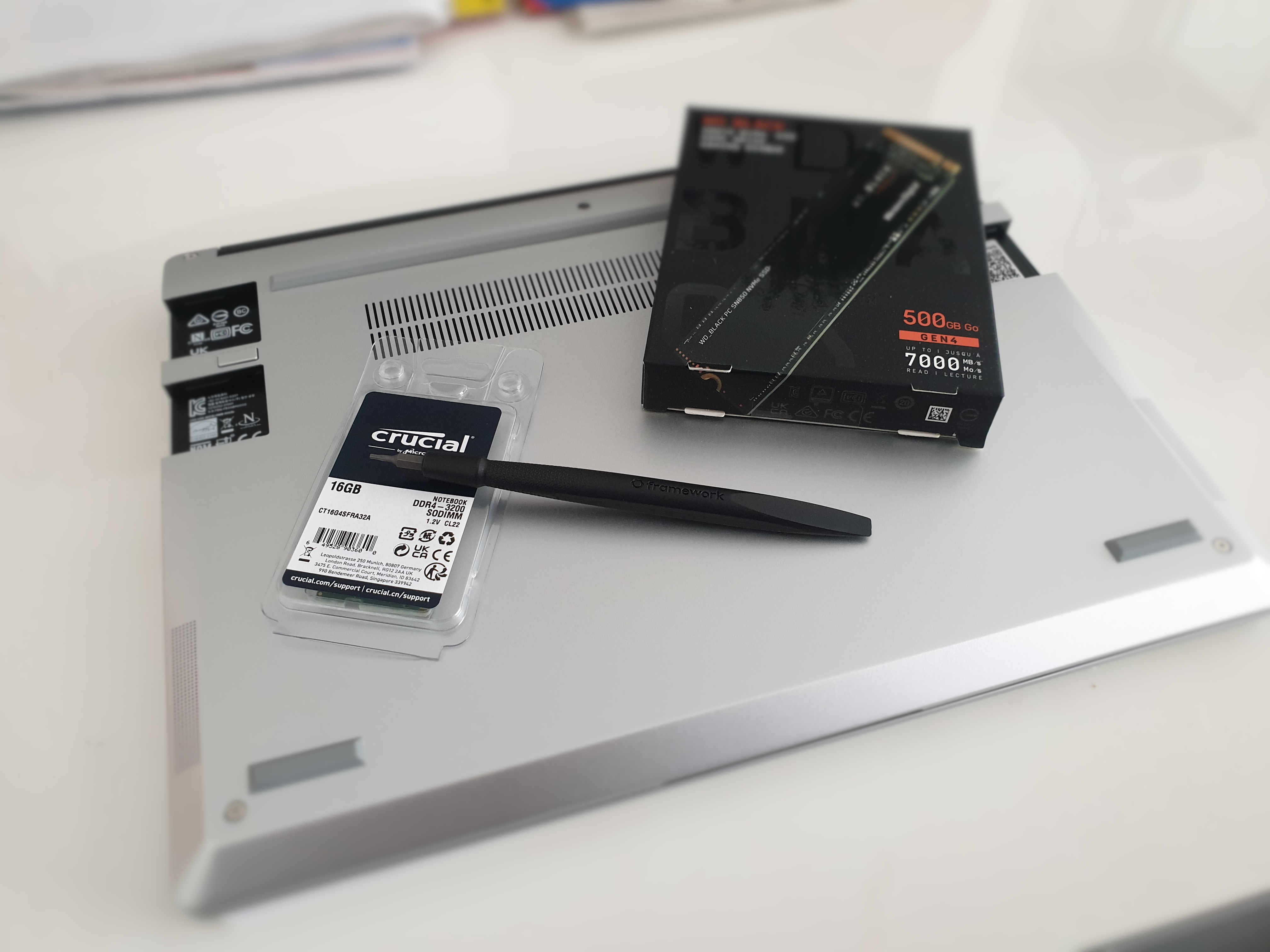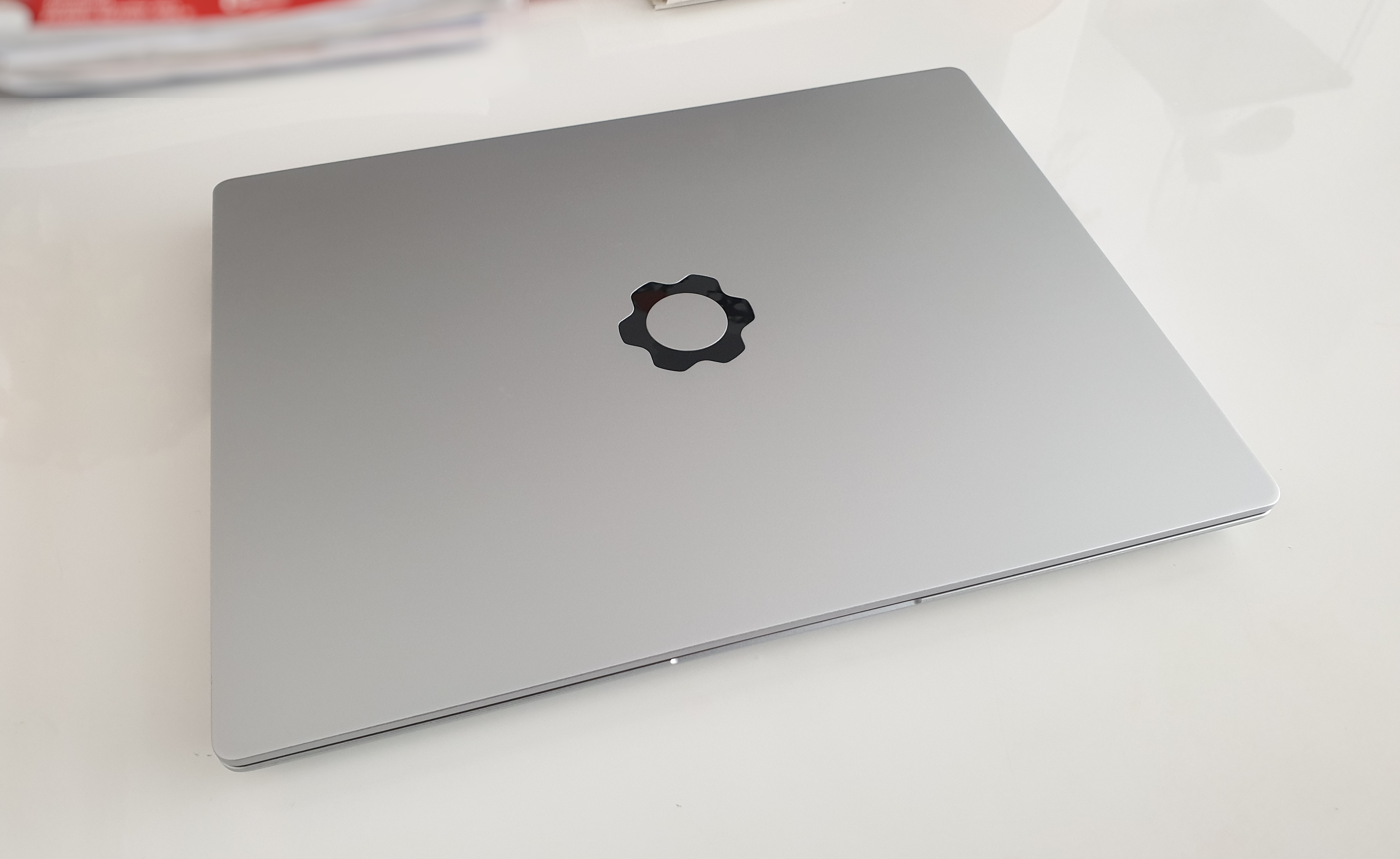

© 2025 DE KOKER Guillaume.
Why a new laptop, and why a framework ?
So, I bought a new laptop !
Actually, it’s not for me. My mom have a 7Y old 17" XPS laptop, Good i7 CPU, 16GB of DDR3 ram, a new SSD and a new battery (they were swappable at the time). She only do lite word processing, email, web browsing and file management on it…
So it was and still is quite enough for here. It should have lasted another 5y easily and everyone would have been happy about it.
But no… the BMS
on the motherboard died 4Y ago and there is no repair program from dell whatsoever…
This left my mom with a laptop unable to charge, tethered to the wall. Plus it was bulky, at the time she insisted on getting a numpad, but 17" was too big to carry.
I was looking around for a new laptop for her for some time now, but everything looked quite horrible. No port, no battery replacement, soldered RAM, no spare part … Honestly, I just didn’t want to give a Dell or a Lenovo my cash for what is basically e-waist in less than 5y.
I was also looking at System76 and other “FOSS
” engaged company, hoping to see something new, but they are mostly software company, and the hardware wasn’t much better.
Out of nowhere, a saw a tweet about a new company wanting to make a reparable laptop.
It was bold, it was modular, and I didn’t believe in it.
Introducing the Framework Laptop, proof that you can build great consumer electronics products that are designed to last.https://t.co/VinUdE1K8u
— Framework (@FrameworkPuter) February 25, 2021
I have seen many of those project in the past pop-up. From “modular phone” that never went anywhere, to “Future proof and evolutive” laptop that never got any upgrade.
This one was a render for sure, nothing to bother with.
But it kept popping up.
On some trust-worthy new’s site…
On some Right to repair focused video …
And finally some reviewer got a product.
I won’t lie, I was blown away. There it was, a laptop from a small company, with a very user-friendly build, easy repairability and spare part. I knew I wanted to support that kind of move, but for now it was only a couple of units and some good review.
After the first wave of actual order when through in the U.S, more and more good new’s were popping up. And it looked like the company were embracing linux too. As soon as I could order from Europe, I did. Sadly, my work had just issued me a new XPS 13 (i don’t like that thing…) so I would not get one for me, but for my mom.
I chose the DIY edition to save a buck, but picked :
- The good enough i5-1135G7
- 1 Stick of 16Gb ram
- 500 GB of WB_Black NVMe SSD
- And a power brick
I could have saved even more by getting my RAM and SSD from Amazon, Framework’s one have quite the markup. But for the same reason I sometime spend more and wait longer to order from our national computer shop, I was more than happy to give to Framework rather than Amazon my money.
IO wise, I took 1 USB A for easy of use, 2 USB C for charging on both side, an HDMI for the TV or when on the go, and a Display port because FINALLY THERE IS ONE ON A LAPTOP. I was sad to not see any Ethernet port though.
They claim it’s on the work, but nothing yet.
An Ethernet Expansion Card is by far the most popular request for extending the capability of the Framework Laptop. It's on our development roadmap, and will be able to slide into any Framework Laptop when we launch it. The benefits of modularity! pic.twitter.com/b15KWUbBne
— Framework (@FrameworkPuter) May 22, 2021
It costed a total 1 271,22 €, including shipping, VAT, Duties, and bank fee I still need to look into. Because I cannot throw that kind of cash to a product, I asked my mom for 700€, the cost of a cheap laptop, and took the rest on me, it was my choice after all.
The laptop
Unboxing and Hardware
The laptop arrived in a brown, sturdy box with some cute art inside. Everything was well packed, and the laptop was in a protective cloth sleeve.
It came with it’s own screwdriver with a reversible bit on it and a spudger at the end. It should be all you need to open, install and/or fix the laptop. There is also a quick guide about flashing the QRcode leading you to the quick start guide.
The laptop himself is very nice. Clean and very sturdy aluminum frame, small footprint, 3:2 display at a nice pixel density (4K on a 13 inch feel foolish to me). The backlit keyboard, here in AZERTY, feel good enough for a laptop and the touchpad is a big one.
Sadly the screen is very wobbly, I fear it will be hard to work on a train or in the wind for example. It’s also very reflective, but nothing a film can’t fix.
Opening it up
Sooooo … its not like I would have opened it up anyway … but I have to install the RAM and SSD you know !
After popping my RAM and SSD in, I closed it up and out of curiosity opened a module.
No glue, I was happy :)
Bios
Did I just say BIOS ? Am I to old to use the proper UEFI name already ?
No, it is an UEFI technically, but gosh does it look retro !

- battery charge limiter
- Power on when plugged in
- CTRL and FN touch swap
- Power button led brightness
It is fun to see how people are digging into what the controller can do and some linux tool are already available if you want to have some fun !
There is still some work going into this BIOS, but it have the fundamental.
Fedora
Installation
Because of the hard turn from Microsoft to a privacy nightmare and ads infested OS, I chose to install Fedora on my Mom computer. I already did a trial with my grandmother 2Y ago when Windows 7 were being deprecated, and for everyday basic task it was more than enough.
I’ve installed Fedora 35 with btrfs default partition mapping, and Gnome. The install went perfectly, no Grub issue and the wireless card was working out of the box. As recommended in the Framework guide to Fedora 35, i’ve added the modprobe option for the audio jack, and enabled gnome experimental scaling (200% was way too big, 150% work very well).
I did all my setup through a simple ansible playbook (you can find it here) just to not forget. One thing that the guide didn’t talk about was that the login screen run under the gdm user, so the same scaling need to be applied there.
Fingerprint and Gnome
It is mostly well know that fingerprint and linux aren’t really good together. Most sensor don’t work, and the system integration isn’t well though trough. Here it’s no exception. The device is recognized by fprintd out of the box which is very nice, but I have no use for it.
I wanted to use it for password-less sign-in like Windows Hello does, and for the Bitwarden client. To me, a well implemented fingerprint system is as safe if not safer than simple password. Sadly that isn’t how fprintd and gnome dev think, and if you log in with the fingerprint, the gnome keyring can’t be unlocked, and you have to enter your password.
My guess is that pam isn’t made for this, and trusting the fingerprint would require a full rewrite of a lot of stuff. Also shell integration for sudo enforce fingerprint by default, breaking Ansible.
Bitwarden also don’t support fingerprint yet, the option is there, but it does nothing.
In the end, I just turned it off. We’ll look at it in a couple years, having it is already a good thing.
Firmware update
Do you have a dell laptop on Fedora ? Maybe with a dell usb c dock issued by your company ? Have you ever experienced the Gnome software + fwupd combo ?
It is AMAZING ! Firmware update drop auto-magically on the classic software update, and you can update your hardware without any CLI.
Now that I have lived with this as an alternative to the otherwise mostly windows exclusive upgrade software. I really wanted it on this laptop.
Well, not yet… but SOON™
We're in the last stages of testing LVFS/fwupd. We've released a community beta firmware update through it previously.
— Framework (@FrameworkPuter) January 6, 2022
Sleep state
Here come the VERY big issue with that laptop under linux, Sleep Hybrid-Sleep and Hibernate/deep-sleep aren’t working correctly.
The laptop battery is good enough if you turn it off when you don’t use it. But most people don’t do that, they shut the lid close, go to a meeting and expect the device to wake up quickly when they open it back up. There is nothing in this that work on the framework under Fedora right now.
First, Fedora migrated from swap to zram by default. Not to get into the detail, zram is basically compressing the ram to save space instead of moving it to the disk. It’s very nice on workstation ~and servers~ but in order to do a deep sleep, you need a place to unload the ram, and now you don’t have one. Sadly it’s also a bit late because booting from swap is way more complex if the swap space is on a BTRFS partition. Think about it during installation.
So, No easy hibernate/deep-sleep
About the lite sleep, it is enabled by default, but it consumes a lot of power.. It’s using s2idle mode, the keyboard stay lit during “sleep”, basically you just turn the screen off…and the battery drain really fast in your bag. Not recommended.
There is a way to switch from lite sleep to hybrid sleep
by adding a boot argument, but it raised another issue, the touchpad don’t support it and the hid_multitouch kernel module need to be restarted. I haven’t made a service and trigger for this yet, but it will be in the Ansible playbook when done. Additionally, waking up take a long time, way too long for a “i open the lid and start working” type of usage.
Wrap-up
That laptop if very nice physically. It is as thin as my XPS 13, as rigid, and have more IO. The screen is OK, same for the keyboard and touchpad, and the modules are a very nice alternative to dongle.
Software wise, maybe it’s better on windows ? I won’t beat them too much over it because we need to encourage manufacturer supporting linux, not have them run away. A laptop without good sleep-state is very sad to see, but it is still early and not a lot of people have one. This laptop will interest a lot of power user, people that can and will find fixes. For my part as it’s not my system I won’t fiddle with it that much.
I’ve skinned it a bit to the linking of its end user, made some direct CIFS automount to better integrate with the system (i don’t like gnome-vfs for daily use) and I will add the touchpad kernel module reload, but that’s it. I need it stable and safe if I want her to keep it.
I hope to see that company grow, so if you need a laptop replacement, for you or at work, please do check them out at frame.work.













